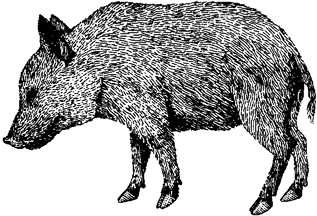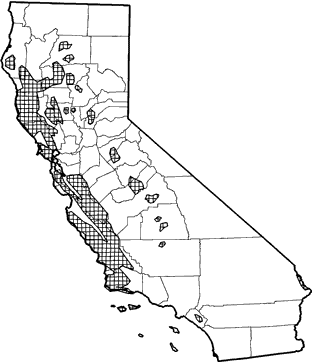
Wild Pig
Distribution, Abundance, and Seasonality
Feral and introduced, permanent resident at low to middle elevations at scattered locations in cismontane California. Common, and increasing in numbers, in local areas. Occur in riparian areas, oak woodlands, annual grasslands, mature conifer and hardwood forests with moderate to high-canopy closure, and in chaparral and other brush areas. Mast crops, especially acorns, important. Adjacent agricultural lands enhance habitat. Barrett (1977) estimated that more than 30,000 wild pigs occur in California, making them the second most important big game species.

Range Map
Specific Habitat Requirements
Feeding: Omnivorous. In Tehama Co., acorns were the most important food. Also ate wild oats and other green grasses, forbs, berries, roots, bulbs, insects, and carrion (Barrett 1978). Forage on ground surface, root beneath ground surface, and forage up to about 0.6 m (2 ft) above ground. Locate food by scent. Will root under logs, rocks, other surface cover, and litter.
Cover: Require dense brush, or rock crevices and caves, for escape and resting cover and shade.
Reproduction: Dense brush areas, or rock crevices and caves, are required for farrowing. Farrowing sites may be dug in earth and lined with vegetation.
Water: Need drinking water at least every 2 days when feeding on dry forage. Mean consumption is 4.1 to 4.5 kg (9-10 lbs) water per day in domestic pigs weighing 68 kg (150 lbs). Water consumption varies with age, ambient temperature and humidity, and moisture content of food.
Pattern: Frequent a mixture of dense brush and forest for cover and reproduction, and oak forests and open, herbaceous areas for foraging.
Species Life History
Activity Patterns: Active yearlong. Mostly crepuscular and nocturnal, some diurnal activity. More nocturnal in hot weather, more diurnal in cold weather.
Seasonal Movements / Migration: Non-migratory, but move seasonally to follow food and water sources.
Home Range: In Tehama Co., home ranges averaged about 52 km? (20 mi?) for males, and about 13 km? (5 mi?) for females. Densities of 5-8 wild pigs per km? (14-20 per mi?) reported in Tehama Co.; 0.5-0.8 per km? (1.3-2.1 per mi?) in Monterey Co.; and 29-39 per km? (75-100 per mi?) in the southeastern U.S. (Pine and Gerdes 1973, Barrett 1978, Wood and Barrett 1979).
Territory: Little information available, but apparently not territorial (Pine and Gerdes 1973). In Tehama Co., Barrett (1978) reported that most groups consisted of a sow and 1-3 generations of offspring. Boars usually were solitary, or in small male groups, except to breed or to feed on a clumped food resource.
Reproduction: Breeding is promiscuous. Estrus occurs every 21 days once females reach sexual maturity, at about 6 mo. Boars display and fight in the presence of estrous sows. After a gestation of about 120 days, an average litter of 5-6 piglets (range = 1-10, or more) is born (Barrett 1978). Young are weaned at 3-4 mo, and females produce 1-2 litters/yr (Barrett 1978).
Niche: Increased reproduction in years of large acorn crop, or other food abundance. Reproductive rate can be increased significantly by access to irrigated pastures and other crops. May be a rangeland and agricultural pest in some areas. Black bears may prey on wild pigs in Humboldt Co. A major adverse impact on native wildlife is competition for mast crop, particularly for acorns in oak woodlands of California. In years of acorn shortage, when competition is most likely to occur, may compete with wild turkeys, mule deer, squirrels, black bears, and other species. Destruction of native vegetation and nests of ground-nesting birds also may be a serious problem (Barrett 1978, Wood and Barret 1979). In Tehama Co., an average adult boar weighed about 80 kg (176 Ibs), and an average adult sow weighed about 75 kg (165 Ibs) (Barrett 1978).
Sources & References
California Department of Fish and Game, 1999.
California's Wildlife, Sacramento, CA.
Written by: G. Ahlborn, reviewed by: M. White, edited by: M. White, G. Ahlborn
Barrett, R. H. 1978. The feral hog on the Dye Creek Ranch, California. Hilgardia 46:283-355. California Department of Fish and Game. 1976. Feral animals in California. Sacramento. Mimeo. 5pp. Mansfield, T. M. 1978. Wild pig management on a California public hunting area. Cal-Neva Wildl. 187-201. Nelson, L., Jr., and J. K. Hooper. 1976. California big game and their management. Univ. Calif., Div. Agric. Sci., Berkeley. Leafl. 2223. 25pp. Pine, D. S., and G. L. Gerdes. 1973. Wild pigs in Monterey County, California. Calif. Fish and Game 59:126-137. Wood, G. W., and R. H. Barrett. 1979. Status of wild pigs in the United States. Wildl. Soc. Bull. 7:237-246.
California Animal Facts | California's Wildlife